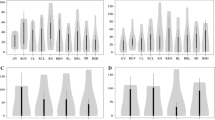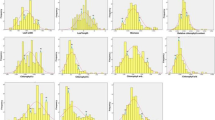Abstract
Drought tolerance was investigated in ‘C306’, one of the most drought tolerant wheat cultivars bred in India in the 1960’s. An intervarietal map** population of recombinant inbred lines of the cross ‘C306’ × ‘HUW206’ was evaluated for drought tolerance components, namely potential quantum efficiency of photosystem (PS) II (Fv/Fm), chlorophyll content (Chl), flag leaf temperature (Lt), and grain yield per plant (Gyp) under stress. Three independent experiments were conducted under well-watered and water-stressed conditions in greenhouses and growth chambers at Kansas State University (USA). Five hundred and sixty microsatellite markers covering the entire genome were screened for polymorphism between the parents. A QTL (QLt.ksu-1D) for Lt (low flag leaf temperature under stress) on the short arm of chromosome 1D between markers Xbarc271 and Xgwm337 at LOD 3.5 explained 37% of the phenotypic variation. A QTL for Fv/Fm (QF v /F m .ksu-3B) and Chl (QChl.ksu-3B) controlling quantum efficiency of PS II and chlorophyll content under stress were co-localized on chromosome 3B in the marker interval Xbarc68–Xbarc101 and explained 35–40% of the phenotypic variation for each trait. A QTL (QGyp.ksu-4A) for Gyp on chromosome 4A at a LOD value of 3.2 explained 16.3% of the phenotypic variation. Inconsistent QTLs were observed for Fv/Fm on chromosomes 3A, 6A, 2B, 4B, and 4D; for Chl on 3A, 6A, 2B and 4B; and for Lt on 1A, 3A 6A, 3B and 5B. The identified QTLs give a first glimpse of the genetics of drought tolerance in C306 and need to be validated in field experiments using the marker-phenotype linkages reported here.


Similar content being viewed by others
References
Blum A (1988) Plant breeding for stress environments. CRC Press, Boca Raton, p 232
Blum A, Ebercon A (1981) Cell membrane stability as a measure of drought and heat tolerance in wheat. Crop Sci 21:43–47
Blum A, Shpiler L, Golan G, Mayer J (1989) Yield stability and canopy temperature of wheat genotypes under drought stress. Field Crop Res 22:289–296
Chaves MM, Maroco JP, Pereira JS (2003) Understanding plant responses to drought: from gene to the whole plant. Funct Plant Biol 30:239–264
Czyczyło-Mysza I, Marcińskaa I, Skrzypeka E, Chrupekala M et al (2011) Map** QTLs for yield components and chlorophyll a fluorescence parameters in wheat under three levels of water availability. Plant Genet Resour Charact Util 9:291–295
Fleury D, Jefferies S, Kuchel, Langridge P (2010) Genetic and genomic tools to improve drought tolerance in wheat. J Exp Bot 61:3211–3222
Ganal MW, Röder MS (2007) Microsatellite and SNP markers in wheat breeding. In: Varshney RK, Tuberosa R (eds) Genomics assisted crop improvement: vol 2: genomics applications in crops, vol 2. Springer, Dordrecht, pp 1–24
Havaux M, Tardy F (1999) Loss of chlorophyll with limited reduction of photosynthesis as an adaptive response of Syrian barley landrace to high light and heat stress. Aust J Plant Physiol 26:569–578
Inagaki MN, Nachit MM (2008). Visual monitoring of water deficit stress using infra-red thermography in wheat. In: Appels R et al (eds) Proc 11th Int Wheat Genet Symp, pp 181, Sydney University Press URL: http://hdl.handle.net/2123/3452
Jiang GH, He YQ, Xu CG, Li XH, Zhang Q (2004) The genetic basis of stay-green in rice analyzed in population of dihybrid lines derived from indica by japonica cross. Theor Appl Genet 108:688–698
Joshi AK, Mishra B, Chatrath R, Ortiz Ferrara G, Singh RP (2007a) Wheat improvement in India: present status, emerging challenges and future prospects. Euphytica 157:431–446
Joshi AK, Chand R, Arun B, Singh RP, Ortiz R (2007b) Breeding crops for reduced-tillage management in the intensive, rice-wheat systems of South Asia. Euphytica 153:135–151
Krause GH, Weis E (1991) Chlorophyll fluorescence and photosynthesis: the basics. Ann Rev Plant Physiol Plant Mol Biol 42:313–349
Kumar S, Prasad LC, Kumar U, Tyagi K, Arun B, Joshi AK (2007) Inheritance and allelic relationship of resistance genes to spot blotch of wheat caused by Bipolaris sorokiniana. In: Buck HT, Nisi JE, Salomón N (eds) Developments in plant breeding vol 12: wheat production in stressed environments. Springer, The Netherlands, pp 113–118
Kumar U, Joshi AK, Kumar S, Chand R, Röder MS (2009) Map** of resistance to spot blotch caused by B. sorokiniana in spring wheat. Theor Appl Genet 118:783–792
Kumar U, Joshi AK, Kumar S, Chand R, Röder MS (2010) Quantitative trait loci for resistance to spot blotch caused by Bipolaris sorokiniana in wheat (T. aestivum L.) lines ‘Ning 8201’ and ‘Chirya 3’. Mol Breed 26:477–491
Lanceras JC, Pantuwan G, Jongdee B, Too**da T (2004) Quantitative trait loci associated with drought tolerance at reproductive stage in rice. Plant Physiol 135:384–399
Lander ES, Green P, Abrahamson J, Barlow A, Daly MJ, Lincoln SE, Newburg L (1987) MAPMAKER: an interactive computer package for constructing primary genetic linkage maps of experimental and natural populations. Genomics 1:174–181
Li RH, Guo PG, Baum M, Grando S, Ceccareli S (2006) Evaluation of chlorophyll content and fluorescence parameters as indicators of drought tolerance in barley. Agric Sci China 5:751–757
McIntyre CL, Mathews KL, Rattey A, Chapman SC et al (2010) Molecular detection of genomic regions associated with grain yield and yield-related components in an elite bread wheat cross evaluated under irrigated and rainfed conditions. Theor Appl Genet 120:527–541
Nachit MM, Monneveux P, Araus JL, Sorrells ME (1998) Relationship of dryland productivity and drought tolerance with some molecular markers for possible MAS in durum (T. turgidum L. var. durum). CIHEAM Opt Mediterr 1:203–206
Nguyen TTT, Klueva N, Chamareck V, Aarti A et al (2004) Saturation map** of QTL regions and identification of putative candidate genes for drought tolerance in rice. Mol Genet Genomics 272:35–46
Nikolaeva MK, Maevskaya SN, Shugaev AG, Bukhov NG (2010) Effect of drought on chlorophyll content and antioxidant enzyme activities in leaves of three wheat cultivars varying in productivity. Rus J Plant Physiol 57:87–95
Nyquist WE (1991) Estimation of heritability and prediction of selection response in plant populations. Crit Rev Plant Sci 10:235–322
Ortiz R, Braun HJ, Crossa J, Crouch J et al (2008) Wheat genetic resources enhancement by the International Maize and Wheat Improvement Center (CIMMYT). Genetic Res Crop Evol 55:1140–1195
Peleg Z, Fahima T, Krugman T, Abbo S, Yakir D, Korol AB, Saranga Y (2009) Genomic dissection of drought resistance in durum wheat/wild emmer wheat recombinant inbred line population. Plant Cell Environ 32:758–779
Pradhan GP, Prasad PVV, Fritz AK, Kirkham MB, Gill BS (2012a) Response of Aegilops species to drought stress during reproductive stages of development. Funct Plant Biol 39:51–59
Pradhan GP, Prasad PVV, Fritz AK, Kirkham MB, Gill BS (2012b) High temperature tolerance in Aegilops species and its potential transfer to wheat. Crop Sci 52:292–304
Prasad B, Carver BF, Stone ML, Babar MA, Rain WR, Klatt AR (2007) Genetic analysis of indirect selection for winter wheat grain yield using spectral reflectance indices. Crop Sci 47:1416–1425
Pruvot G, Cuine S, Peltier G, Rey P (1996) Characterization of a novel drought-induced 34-kDa protein located in the thylakoids of Solanum tuberosum L. plants. Planta 25:471–479
Ristic Z, Bukovnik U, Prasad PVV (2007) Correlations between heat stability of thylakoid membranes and loss of chlorophyll in winter wheat under heat stress. Crop Sci 47:2067–2073
Röder MS, Korzun V, Wendehake K, Plaschke J, Tixier M-H, Leroy P, Ganal MW (1998) A microsatellite map of wheat. Genetics 149:2007–2023
Saghai-Maroof MA, Soliman KM, Jorgensen RA, Allard RW (1984) Ribosomal DNA spacer length polymorphisms in barley: Mendelian inheritance, chromosomal location, and population dynamics. Proc Natl Acad Sci USA 81:8014–8018
SAS Institute (1988) SAS/Stat user’s guide. Release 6.03 ed. SAS Inst., Cary, NC
Sirault XRR, James RA, Furbank RT (2009) A new screening method for osmotic component of salinity tolerance in cereals using infrared thermography. Funct Plant Biol 36:970–977
Somers DJ, Issac P, Edwards K (2004) A high-density microsatellite consensus map for bread wheat (Triticum aestivum L.). Theor Appl Genet 109:1105–1114
Tambussi EA, Bartoli CG, Beltrano J, Guimet JJ, Araus JL (2000) Oxidative damage to thylakoid proteins in winter stressed leaves of wheat. Physiol Plantarum 108:398–404
Tuberosa R, Salvi S (2006) Genomics-based approaches to improve drought tolerance of crops. Trends Plant Sci 8:405–412
Wang S, Basten CJ, Zeng ZB (2007) Windows QTL Cartographer, new version, Department of Statistics, North Carolina State University, Raliegh, N.C. (http://statgen.ncsu.edu/qtlcart/WQTLCart.htm)
Yang J, Sears RG, Gill BS, Paulsen GM (2002) Genotypic differences in utilization of assimilate sources during maturation of wheat under chronic heat and heat shock stresses. Euphytica 125:179–188
Zadoks JC, Chang TT, Konzak CF (1974) A decimal code for the growth stages of cereals. Weed Res 14:415–421
Zaharieva M, Gaulin E, Havaux M, Acevedo E, Monneveux P (2001) Drought and heat responses in the wild wheat relative Aegilops geniculate Roth. Crop Sci 41:1321–1329
Acknowledgments
This research was supported by the Ministry of Science and Technology, Government of India, Delhi, through a Better Opportunities for Young Scientists in Chosen Areas of Science and Technology (BOYSCAST) Fellowship to Dr. Sundeep Kumar for doing advanced research at the Wheat Genetic and Genomic Resources Center, Kansas State University. We also acknowledge a Coordinated Agricultural Project Grant (no. 2011–68002–30029, Triticeae-CAP) from the USDA National Institute of Food and Agriculture for partial financial support. We thank Duane Wilson and Jon Raupp for excellent technical assistance. This is contribution no. 12-256-J from the Kansas Agricultural Experiment Station, Manhattan, KS 66506-5502.
Author information
Authors and Affiliations
Corresponding author
Rights and permissions
About this article
Cite this article
Kumar, S., Sehgal, S.K., Kumar, U. et al. Genomic characterization of drought tolerance-related traits in spring wheat. Euphytica 186, 265–276 (2012). https://doi.org/10.1007/s10681-012-0675-3
Received:
Accepted:
Published:
Issue Date:
DOI: https://doi.org/10.1007/s10681-012-0675-3




